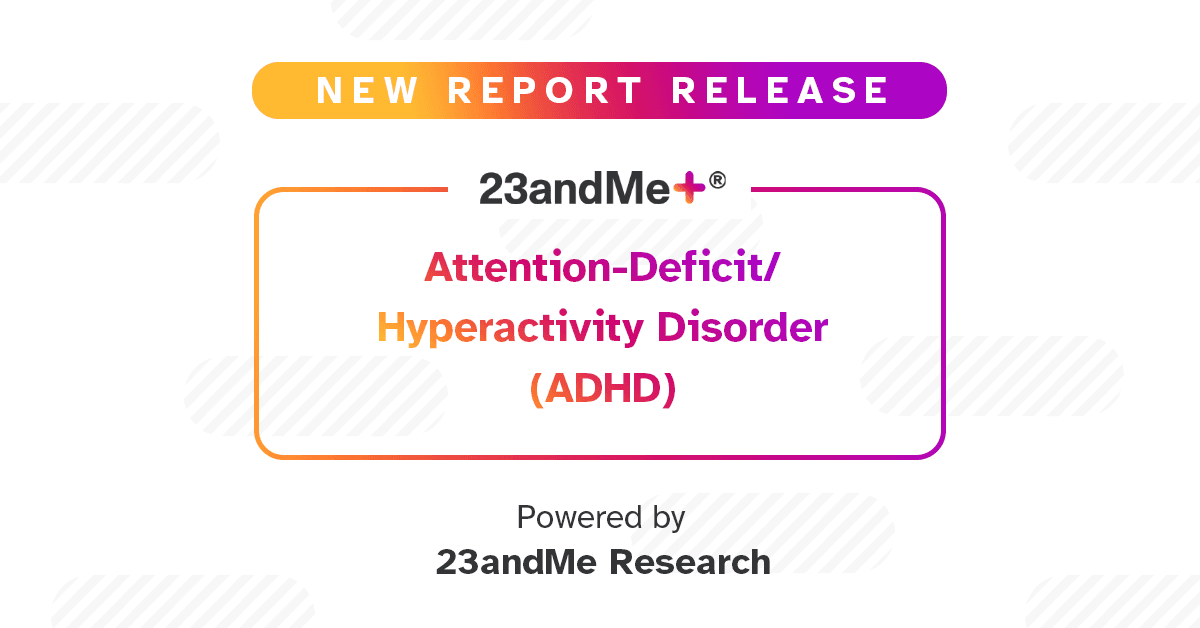This week, we released a new report powered by 23andMe research on attention deficit/hyperactivity disorder (ADHD) for 23andMe+ Premium members.
What is ADHD?
ADHD is caused by differences in the brain that can affect attention, working memory, and something called “executive function” or the way the brain prioritizes or manages thoughts and behaviors. These differences can contribute to things like feeling restless, frequently losing things, difficulty completing tasks or projects, difficulty concentrating, forgetting important things, and/or difficulty coping with intense emotions. But these characteristics can show up differently in different people.
While anyone may occasionally experience those feelings or impulses, for those with ADHD these characteristics persist over time and can impact other areas of life like their ability to study, work and interact with others.
ADHD can also impact one’s health. Those with ADHD may be more likely to experience sleep disorders, for instance, mental health conditions like anxiety or depression, or substance abuse issues. But many people with ADHD report that there are also positive effects of having ADHD including being adventurous, creative, and hyper focused.
Prevalence
ADHD is most often diagnosed in children, but it could affect people of any age.
Just under 10 percent of children have been diagnosed with ADHD, according to the Centers for Disease Control and Prevention. It’s almost twice as likely to be diagnosed in boys, with about 13 percent of boys having an ADHD diagnosis compared to about 6 percent of girls. However, it’s not clear whether boys more frequently experience ADHD, because ADHD may be harder to recognize in girls compared to boys. It is challenging to get an accurate estimate of ADHD prevalence in adults but one 2006 study by researchers at Harvard Medical School’s Department of Public Health estimated that it affects 4 percent of adults. However other studies have found the prevalence to be even higher.
23andMe’s report is focused on adults and does not look at diagnosis of ADHD in childhood.
Our new report
23andMe’s new Attention Deficit/Hyperactivity Disorder report is powered by data from people who have consented to participate in 23andMe research. The report uses machine learning techniques to estimate an individual’s likelihood of being diagnosed with ADHD.
This estimate is made using a statistical model that includes thousands of genetic markers and information on an individual’s ethnicity and birth sex. You can learn more about the science and methodology behind our new report in this white paper.
Genetic factors
Based on a large twin study, it is estimated that about 70-80 percent of the chances of developing ADHD may be explained by genetic factors. Scientists are still learning more about the genes involved and about other factors that may be involved in ADHD predisposition.
Living with ADHD
When characteristics of ADHD become problematic, they can be managed with medication, or with accommodations at the workplace or school. In addition, having support from a psychotherapist or counselor, who can offer behavioral strategies can also help.
Strategies that many people with ADHD find helpful include tools used to help in organizing time or space. Improving sleep can also go a long way toward helping alleviate problems, so it’s often a good first problem to tackle. To address sleep issues, those with ADHD have been helped by improving sleep habits, better bedtime routines, and limits on screen time before bedtime, for instance, but if that’s not enough additional treatment may be needed.
In addition, for people who want to support others with ADHD, a good first step is educating yourself about ADHD and learning how to adjust your actions and communication style to better accommodate their needs.
As we mentioned above, many people with ADHD find the focus in medical research on the negative impacts are often more related to external standards imposed by society. Finding ways to adapt schools, workplaces or other institutions to accommodate those with ADHD would help reduce the challenges that people with ADHD may face. It’s also important to know that recent studies looking at perspectives from those with ADHD found that a majority said there were many positive aspects of having ADHD. Among the traits they saw as positive were their drive, adventurousness, creativity, flexibility, hyper-focus and willingness to assist others.
Learn more
23andMe’s new Attention Deficit/Hyperactivity Disorder (powered by 23andMe Research) is available to all annual members of the 23andMe+ Premium Membership.
To view your report, go here.
Want to join our 23andMe+ Premium Membership?
Find out more here.




